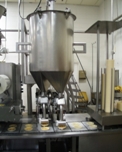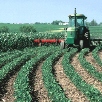
Recalls: Are You Prepared for the Worst?
Establishments should test their ability to make and execute a plan by carrying out periodic recall simulations. This allows personnel to become familiar with recall procedures.
Responding to a recall is something no food company wants to have to do, but recalls do happen. Both the Food and Drug Administration (FDA) and U.S. Department of Agriculture (USDA) frequently issue recall notices. In fact, FDA recently issued a Class I recall for contaminated hydrolyzed vegetable protein (HVP) used as a flavor enhancer in a wide variety of processed foods, affecting hundreds of products and dozens of companies.
 The magnitude of the HVP recall has once again thrust the issue of food safety into the public spotlight. Even though no illnesses have been specifically attributed to these products, consumers continue to be at risk of foodborne illness from contaminated food. Despite industry's best efforts, is it realistic to think it is not a matter of whether a product will be involved in a recall, but rather when?
The magnitude of the HVP recall has once again thrust the issue of food safety into the public spotlight. Even though no illnesses have been specifically attributed to these products, consumers continue to be at risk of foodborne illness from contaminated food. Despite industry's best efforts, is it realistic to think it is not a matter of whether a product will be involved in a recall, but rather when?
That's difficult to say, but being prepared for the worst can minimize the effects of a recall because the time to begin is not when the crisis hits.
Have a Plan
In a recent report published by the Produce Safety Project, it was estimated foodborne illnesses cost the United States $152 billion annually in health care and other losses. For industry, the losses associated with a recall can include legal costs and liabilities resulting from customer claims, loss of market share, and damage to the brand name and corporate image. The direct cost of product removal and disposition also must be considered.
Obviously, a recall is a frightening prospect; however, companies can minimize these losses. One way to do this is to have a recall program in place that will enable the company to effectively and efficiently remove product from the marketplace, if necessary. As part of the program, a detailed, written plan should be prepared and maintained that describes assigned responsibilities and procedures to follow in the event of a recall.
Manage
Due to the complexity of evaluating and conducting recall actions, companies should clearly define and assign recall responsibilities in the plan. One person should be identified as the recall coordinator to oversee all activities related to recalls. The recall coordinator should be knowledgeable about every aspect of the company's operations. This individual should also be authorized to make decisions in carrying out a recall and should report to top management at regular, specified intervals.
Other individuals should be selected to form a recall team. Each team member's responsibilities should be based upon his respective areas of knowledge, such as quality control, sales, receiving, shipping, production, etc. Be specific in assignments and consider responsibilities for:
- Traceability to determine where raw materials were used, quantity of product produced, production dates, distribution information, etc.;
- Risk assessment and hazard evaluation;
- Communications with media and government;
- Physical containment of the product; and
- Disposition of the product.
Develop a contact list identifying team members' telephone numbers (both work and home), work hours, e-mail addresses, etc. Also, identify alternates for each team member, including the coordinator. Keep all of this information readily accessible to assist members who must rapidly respond to a recall. Outline in the plan the specific training, if necessary, that team members receive as a result of their participation.
Evaluate
The first step in a recall process often involves evaluating the necessity of a recall. This could be due to customer complaints, internal product test results, HACCP verification activities, third-party notifications (e.g., state health department), etc. Whatever the cause, the procedures used to assess such complaints or conditions should be clearly outlined in the plan.
Identify
If a recall is necessary, it is essential to be able to quickly and accurately identify and locate suspect product. Without good traceability, more product than necessary may need to be recalled in order to ensure that all of it has been retrieved. As such, a company needs to accurately identify:
- All suspect ingredients, packaging materials, and associated products;
- Brands, sizes, labels, stock-keeping units, and other identifying information;
- The quantity of product affected;
- Date(s), lot codes, and times the product was produced and distributed;
- The distribution pattern and area of distribution, including domestic and foreign sales;
- Consignees that received the recalled product, including addresses, contact names, telephone numbers, account type (e.g., manufacturer, distributor, retailer); and
- The amount of product remaining under the company's control and in the marketplace.
The recall plan should outline when and how the company will make these determinations for various scenarios and contingencies.
Notify
Notification must be done in a timely manner. As such, the plan needs to specify who will be notified of the recall. At a minimum, this includes:
- Regulatory officials. The recall plan should specify the procedure to notify the required USDA or FDA officials and what information (e.g., product identity, associated risks, and distribution channels) will be provided to the agency. This should be done at the earliest opportunity after the decision to recall a product is made. This will allow each agency to offer guidance and assistance in the recall process.
- Consignees. The plan should specify what means of communication will be used to notify consignees. This notification may be made via letter, telephone, fax, or a combination of these methods. Include a sample of the correspondence intended to be used that provides all relevant recall information and conveys the product in question is subject to a recall, that further distribution or use of any remaining product should cease immediately, that the direct consignee should notify its consignees that received the product about the recall, instructions regarding what to do with the product, and contact information for questions.
- Customers. They should be notified by the most effective method available (e.g., press release). The recall plan also should include contact information for all potential local, state, and regional media outlets, such as television stations, radio stations, and newspapers. If a press release will be used to notify customers, a prepared sample should be included in the plan.
Remove, Control, and Dispose
A company must make reasonable efforts to remove all affected products from commerce. This can be a difficult and complicated task. As such, specific procedures should be included in the recall plan that address the removal, control, and disposition of product. This could include details on how the company would:
- Recover the product from consignees and other sources (e.g., inventory on site, in transit, and at off-site distribution locations);
- Identify and mark affected product;
- Segregate returned product;
- Prevent product from re-entering commerce;
- Redirect, destroy, or recondition product; and
- Document all quantities, identification codes, and disposition actions.
These procedures are often dependent on the nature of the recall. However, having a plan on how the company will coordinate these activities will help to effectively utilize resources and reduce disruptions in production.
Validate
The company is responsible for validating that the recall is effective. This is done through the use of effectiveness checks. The purpose of effectiveness checks is to verify all consignees affected by the recall have received the required notification and have taken appropriate action to remove the product from commerce.
The recall plan should specify the methods for contacting consignees (e.g., personal visits, telephone calls, letters, fax, or a combination thereof). The method for determining the number of effectiveness checks to be conducted throughout the recall process also should be determined and detailed in the plan. At some point, the company may need to reassess the recall strategy, should the response from consignees be less than 100 percent. If this is the case, the actions the company will take should also be detailed in the plan.
Terminate
The recall plan should also include the company's procedures to notify agency officials and consignees that the recall has been completed. This should be considered only after all reasonable efforts have been made to remove the affected product from commerce, effectiveness checks have been made, and disposition of the product has been completed. A final status report containing all relevant information should be provided to FDA or USDA, who will make a final decision to terminate the recall.
Simulate
Establishments should test their ability to make and execute a recall plan by carrying out periodic recall simulations. This allows the company to test the effectiveness of the recall plan and allows personnel to become familiar with recall procedures. Therefore, the plan should outline the scope and frequency of the simulations, product selection guidelines, documentation requirements, follow-up activities, etc.
Conclusion
The effects of a recall can be devastating for a food company. However, advanced preparation can minimize the risk of harm to the public and your company's image. Just knowing what to do in the event of a recall is not enough. A well-written and -executed plan will ensure a company is able to handle a recall with success.
About the Author
Jennifer Stroschein joined J. J. Keller & Associates, Inc. in 1998 with a BA in Environmental Studies and Biology and expertise in regulatory compliance with federal regulations and standards. As Editor – Workplace Safety, she is responsible for providing timely, accurate information and technical support to workplace safety professionals regarding a variety of issues. Her areas of specialty include safety incentive programs, audits and inspections, walk-working surfaces, and pandemic preparedness.